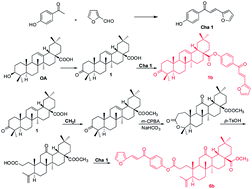Synthesis and biological evaluation of oleanolic acid derivative–chalcone conjugates as α-glucosidase inhibitors†
Abstract
α-Glucosidase is a promising target for the treatment of obesity and diabetes mellitus. A series of oleanolic acid derivative–chalcone conjugates were designed and synthesized as α-glucosidase inhibitors. Their structures were determined by spectroscopic analysis and their α-glucosidase inhibitory activities were investigated in vitro. Most conjugates exhibited moderate inhibitory activity against α-glucosidase; among them, conjugate 1b (IC50 = 3.2 ± 0.2 μM) possessed the strongest α-glucosidase inhibitory activity, and the preliminary structure–activity relationship showed that the furan or thiophene rings in the chalcone units of the conjugates had a tendency to enhance the activity. Lineweaver–Burk plot analysis demonstrated competitive inhibition of α-glucosidase activity by 1b, 6b, 5c and 4d; their inhibition constant (Ki) values were 16.6, 29.3, 14.6 and 20.6 μM, respectively. The interaction forces between the conjugates and α-glucosidase were hydrogen bonding and van der Waals.


 Please wait while we load your content...
Please wait while we load your content...